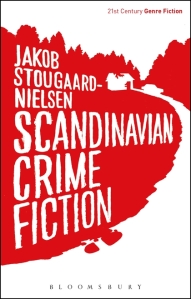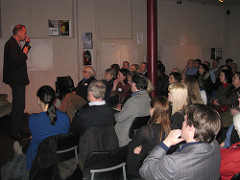Jakob Stougaard-Nielsen’s (UCL Scandinavian Studies) book, Scandinavian Crime Fiction, is published by Bloomsbury on 12 January 2017. See further down for information about the book and where to buy a copy with a special Nordic Noir Book Club offer.
Writing the book
Writing this book has been quite a personal journey for me. I grew up in Denmark in the 1970s and 80s – the period crime writers like Anders Bodelsen in Denmark, Sjöwall and Wahlöö in Sweden and Gunnar Staalesen in Norway in various ways, sub-genres and temperaments depicted as the end to the utopian dream of the Scandinavian welfare societies. Revisiting this period through the psychological and social dystopias portrayed in these proto-Nordic Noir novels has been a fascinating and at times disorienting journey – in the first three chapters of my book, I discuss these writers in the context of dramatic societal changes and historical events, and how these writers laid out the paths to be followed by Mankell, Høeg and Ekman in the 90s, Stieg Larsson, Arne Dahl, Nesbø, Holt and Danish TV crime in the 2000s.
While as a child of the 70s and 80s I was sheltered from many of the concerns and uncertainties that followed dramatic changes to the urban environments, consumer behaviours, environmental and demographic changes and growing social and political conflicts, my research did remind me of insecurities that even a child in the relatively peaceful periphery of the Nordic countries could sense: oil crises that led to car-free Sundays, the scare of nuclear fallout, strikes, demonstrations, and, in the 80s, Russian submarines, the murder of Olof Palme and an increasingly stranger globalized and mediatized world.
As I argue in the book, if contemporary crime writing is to be considered, in equal measures, a seismograph and a lightening rod for collective social anxieties and an expressive form that demands and desires social cohesion and justice, at least on the level of the individual, so did the front-runners of the socio-critical Scandinavian crime novel from the 60s t0 the 90s use the genre not only to entertain and frighten but also to engage a wide readership in a form of collective detection of social ills and their possible cures.
Scandinavia – through the looking-glass
Since the beginning of the Nordic Noir phenomenon in the UK around 2010, I have been repeatedly asked by journalists and readers, I have met through my work in London, how it can be that so many dark and disturbing crime novels and TV series come out of Scandinavia these days. It is, understandably, not less puzzling to readers and viewers in the UK, as the Nordic countries are best known here for their healthy, happy and ‘hyggelige’ welfare societies?
While I have over the years always attempted to provide relevant answers to what is by no means a simple issue ‘coincidense’, writing this book has of course given me the opportunity to dig a great deal deeper and to include a wide range of both ‘classical’ crime novels and TV series from Denmark, Norway and Sweden since the late 1960s and lesser known works by, for instance, Bodelsen, Staalesen and Holt in my reply. As the reader will notice, I have also had the space to explore the most important cultural and political contexts for understanding the origins and local conditions that eventually gave us the Nordic Noir “crime wave”.
It is my hope that readers will enjoy, like I did, this journey back to the recent past of three ‘not-so-foreign countries’ in order to reach into our confusing present, where Scandinavia has become, for a lack of a better description, Britain’s strangely familiar yet still rather exotic – if not frightening – wonderland.
A Nordic Noir Book Club Book
As I write in the preface to the book, it grew out of meetings and conversations we have had in the Nordic Noir Book Club. The Book Club, as readers of this blog will know, was conceived in 2010 as a way for scholars and students in the Department of Scandinavian Studies, University College London, to engage with fans and readers of Scandinavian crime fiction in an exploration of what the success of ‘Nordic Noir’ could tell us about how Nordic cultures and societies are presented and understood in the UK through the popular forms of translated and subtitled crime fiction. I am particularly grateful to the many members of the Nordic Noir Book Club, who have generously shared their insights and enthusiasm for crime fiction and the Nordic countries.
How to buy the book
To purchase a copy with a 20% discount and free delivery, order from Bloomsbury press and enter the code GRL7DF at the checkout: http://bloomsbury.com/uk/scandinavian-crime-fiction-9781472527745/
About Scandinavian Crime Fiction
With its bleak urban environments, psychologically compelling heroes and socially engaged plots, Scandinavian crime writing has captured the imaginations of a global audience in the 21st century. Exploring the genre’s key themes, international impact and socio-political contexts, Scandinavian Crime Fiction guides readers through such key texts as Sjöwall and Wahlöö’s Novel of a Crime, Gunnar Staalesen’s Varg Veum series, Peter Høeg’s Miss Smilla’s Feeling for Snow, Henning Mankell’s Wallander books, Stieg Larsson’s Millennium trilogy and TV series such as The Killing. With its focus on the function of crime fiction in both reflecting and shaping the late-modern Scandinavian welfare societies, this book is essential for readers, viewers and fans of contemporary crime writing.
Table of contents
Introduction
1. Scandinavian crime fiction and the welfare state
2. Welfare crime: Sjöwall and Wahlöö’s Novel of a Crime
3. The hardboiled social worker: Gunnar Staalesen’s Varg Veum
4. Crime fiction in an age of crisis: Henning Mankell’s Faceless Killers and Stieg Larsson’s The Girl with the Dragon Tattoo
5. Landscape and memory in the criminal periphery
6. Criminal peripheries: Peter Høeg’s Miss Smilla’s Feeling for snow and Kerstin Ekman’s Blackwater
7. Investigating the family in the welfare state
Conclusion
Reviews & endorsements
“No cultural phenomenon of our times is more important than Nordic noir, its origins, its continuing existence and appeal, the needs it meets. All these Jakob Stougaard-Nielsen addresses with searching intelligence and sharp moral awareness. He explores what the Scandinavian societies have in common, and illuminates what differentiates them and their literary productions: how Sweden coped with Palme’s assassination and Chernobyl; how Norway has adapted to its oil richness and, more recently, has tried to make sense out of Breivik’s multiple murders. He discusses all his authors and their works with probing attentiveness, but gives detailed and wholly revelatory readings of two novels that ushered in the movement – Peter Høeg’s Miss Smilla and Ekman’s Blackwater – and of Anne Holt’s post-Breivik novel What Dark Clouds Hide. He is equally insightful on the Danish TV series, The Killing and The Bridge. It is precisely through the intensity of this author’s approach to his subject that its universality becomes apparent: the interconnectedness of geography, politics, social composition and the arts, and the indomitable, demanding presence of crime in even the best-intentioned milieus. A fascinating and distinguished book, and a necessary one too.” – Paul Binding, novelist, critic, poet and cultural historian. Binding frequently contributes reviews to The Independent and The Times Literary Supplement.
I have to say that objectively speaking, [Jakob Stougaard-Nielsen] is one of the pre-eminent commentators on the genre, taking on the societal and psychological elements of Nordic Noir with a precision worthy of some of the great Nordic detectives. In this academic but accessible volume, the familiar themes of the field (notably the flaws of the societies in which the murderous activities of Nordic Noir take place) are treated with an analytical precision that both anatomises the key elements for those new to the genre and finds myriad new insights for old hands like myself. Scandinavian Crime Fiction becomes, at a stroke, a key work in the ongoing analysis of Nesbo, Larsson, Fossum, Mankell & Co., crammed with acute observation from a man whose knowledge and understanding of the genre is nonpareil (read the full review at Crime Time). – Barry Forshaw, editor and reviewer at crimetime.co.uk, author of Death in a Cold Climate: A Guide to Scandinavian Crime Fiction, Nordic Noir: The Pocket Essential Guide to Scandinavian Crime Fiction, Euro Noir and Brit Noir.
Excellent, admirably inclusive in its range of material, Scandinavian Crime Fiction addresses a fundamental question: what is it about these wealthy, egalitarian, socially secure states that has given rise to such a bleak and disturbing genre? And further, what might account for the success of Nordic Noir outside, as well as inside, its local readership? Stougaard-Nielsen explores it using a wealth of persuasive sociological and historical detail. Times Literary Supplement, May 12 2017.
Stougaard-Nielsen brings new works under study and challenges some received opinions. Both solidly academic and highly accessible, Stougaard-Nielsen’s book should prove a standard reference point for critics of contemporary crime fiction, and a way into the complexities of its contexts for the general reader. Tim Morris, lection, July 19 2017.
In this upsurge of research into regional crime fiction from the Scandinavian region, principally Sweden and Swedish authors have effectively caught the attention of both Scandinavian and non-Scandinavian scholars, and for good reason since Swedish authorships have been forerunners for decades. For some reasons, however, we have for years been missing an English title on the pan-regional scope of the genre; a focus on a genre that has had a deep intra-regional generic development besides the obvious international inspiration from especially English and American crime fiction. Now, Jakob Stougaard-Nielsen’s Scandinavian Crime Fiction finally fills this void with a compelling and recognizable take on the genre’s most important developments since the 1960s. Kim Toft Hansen, Kulturkapellet, August 16 2017.
Related publications by Jakob Stougaard-Nielsen
- ‘Nordic Queens of Crime 1990-2013‘ (online article in The History of Nordic Women’s Literature, 2016)
- ‘Nordic Noir in the UK: The Allure of Accessible Difference‘ (online article in Journal of Aesthetics & Culture, 2016)
- ‘Criminal Logistics: Globalization, Containerization and Tragedy in Scandinavian Crime Fiction‘ (online article in Journal of World Literature, 2016)
- ‘The Policeman in the Ill-Fitting Uniform; or, How to write crime fiction after Utøya‘ (online article in Post45, 2015)
- ‘The truth is, Scandinavia is neither heaven nor hell‘ (online article in The Conversation, 2014)
- ‘Should we trust the Danes? The World Happiness Report 2013‘ (online article @ UCL European Institute, 2013)





